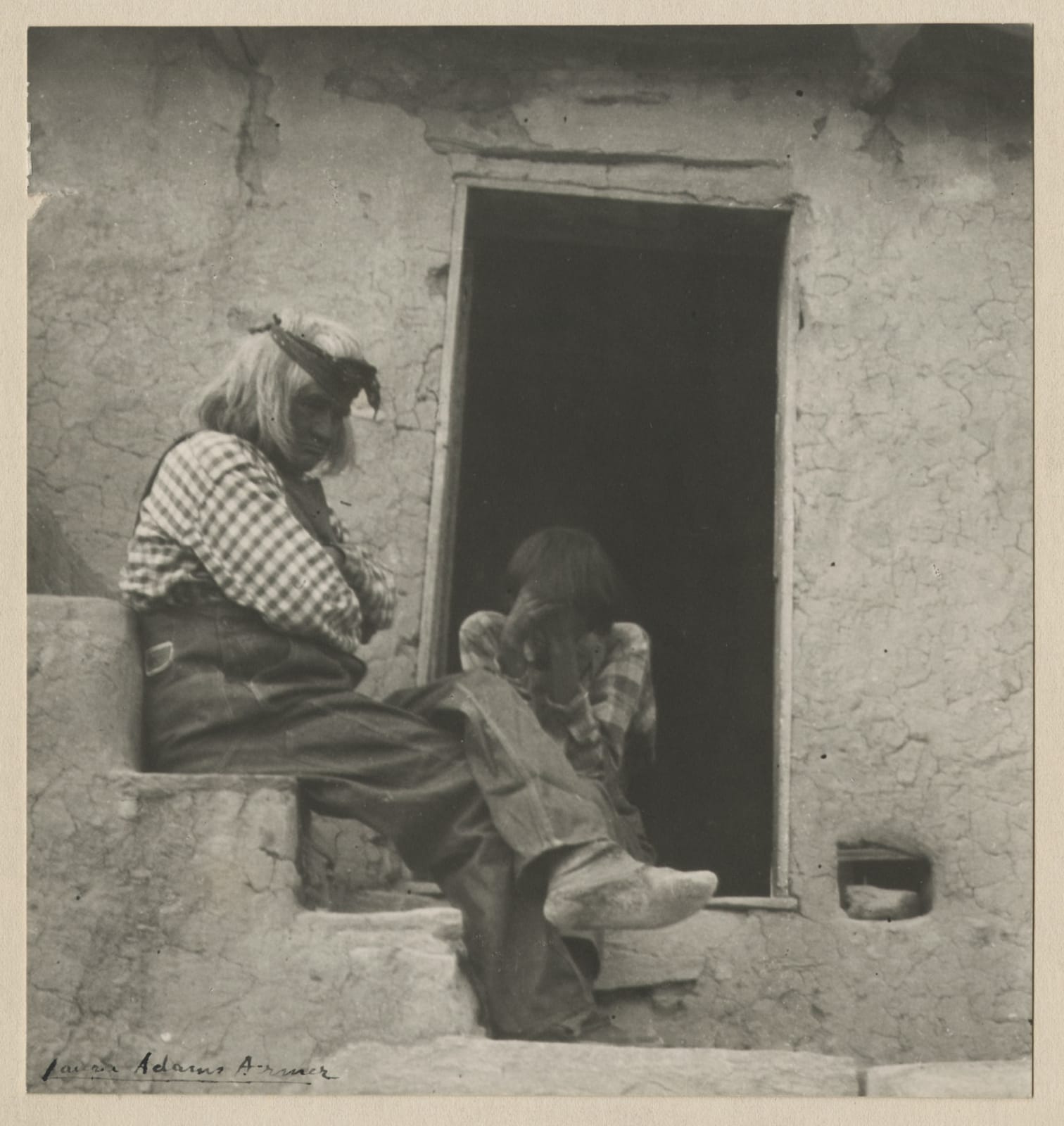Laura Adams Armer
Collection of Pictiorialist Portraits of the Hopi and Navajo, 1920s
Silver prints (13)
7 3/4 x 9 3/4 to 8 1/2 x 4 inches; 7 mounted
7 signed recto or verso.
7 signed recto or verso.
Further images
-
(View a larger image of thumbnail 1
)
![[Rodney King], Dramatic Aerial Views of the Los Angeles Uprising, 1992](https://artlogic-res.cloudinary.com/w_150,h_150,c_fill,f_auto,fl_lossy,q_auto/artlogicstorage/dollc/images/view/08e669ddbc9e97abaadf4da43983d126j/daniel-oliver-laura-adams-armer-collection-of-pictiorialist-portraits-of-the-hopi-and-navajo-1920s.jpg)
-
(View a larger image of thumbnail 2
)
![[Rodney King], Dramatic Aerial Views of the Los Angeles Uprising, 1992](https://artlogic-res.cloudinary.com/w_150,h_150,c_fill,f_auto,fl_lossy,q_auto/artlogicstorage/dollc/images/view/05f81ebebc58ba82824eb94f525b422aj/daniel-oliver-laura-adams-armer-collection-of-pictiorialist-portraits-of-the-hopi-and-navajo-1920s.jpg)
-
(View a larger image of thumbnail 3
)
![[Rodney King], Dramatic Aerial Views of the Los Angeles Uprising, 1992](https://artlogic-res.cloudinary.com/w_150,h_150,c_fill,f_auto,fl_lossy,q_auto/artlogicstorage/dollc/images/view/6a7ec39ab6d7d9c2c459439f825a8f7fj/daniel-oliver-laura-adams-armer-collection-of-pictiorialist-portraits-of-the-hopi-and-navajo-1920s.jpg)
-
(View a larger image of thumbnail 4
)
![[Rodney King], Dramatic Aerial Views of the Los Angeles Uprising, 1992](https://artlogic-res.cloudinary.com/w_150,h_150,c_fill,f_auto,fl_lossy,q_auto/artlogicstorage/dollc/images/view/37ffbe230cc52fc3e777129d9e0efab7j/daniel-oliver-laura-adams-armer-collection-of-pictiorialist-portraits-of-the-hopi-and-navajo-1920s.jpg)
-
(View a larger image of thumbnail 5
)
![[Rodney King], Dramatic Aerial Views of the Los Angeles Uprising, 1992](https://artlogic-res.cloudinary.com/w_150,h_150,c_fill,f_auto,fl_lossy,q_auto/artlogicstorage/dollc/images/view/8f58c76de1801fc6f758009a0ab6fe6cj/daniel-oliver-laura-adams-armer-collection-of-pictiorialist-portraits-of-the-hopi-and-navajo-1920s.jpg)
-
(View a larger image of thumbnail 6
)
![[Rodney King], Dramatic Aerial Views of the Los Angeles Uprising, 1992](https://artlogic-res.cloudinary.com/w_150,h_150,c_fill,f_auto,fl_lossy,q_auto/artlogicstorage/dollc/images/view/e7c30fe31dbde65b40edb9cd852b334cj/daniel-oliver-laura-adams-armer-collection-of-pictiorialist-portraits-of-the-hopi-and-navajo-1920s.jpg)
-
(View a larger image of thumbnail 7
)
![[Rodney King], Dramatic Aerial Views of the Los Angeles Uprising, 1992](https://artlogic-res.cloudinary.com/w_150,h_150,c_fill,f_auto,fl_lossy,q_auto/artlogicstorage/dollc/images/view/bd7688cdbd982e6128554b1de9370809j/daniel-oliver-laura-adams-armer-collection-of-pictiorialist-portraits-of-the-hopi-and-navajo-1920s.jpg)
-
(View a larger image of thumbnail 8
)
![[Rodney King], Dramatic Aerial Views of the Los Angeles Uprising, 1992](https://artlogic-res.cloudinary.com/w_150,h_150,c_fill,f_auto,fl_lossy,q_auto/artlogicstorage/dollc/images/view/0120bb46c21d9a80c24fefc83b01ef71j/daniel-oliver-laura-adams-armer-collection-of-pictiorialist-portraits-of-the-hopi-and-navajo-1920s.jpg)
A rare suite of photos by the California pictorialist Laura Adams Armer, documenting the lives of the Hopi and Navajo people. Included are many sensitive portraits of women and children...
A rare suite of photos by the California pictorialist Laura Adams Armer, documenting the lives of the Hopi and Navajo people. Included are many sensitive portraits of women and children performing important daily routines such as drying peaches, flaying sheep, and shucking corn. Also included is a beautiful image of an elderly man and young child titled "Old Oraibi" (the name of a a Hopi village in Navajo County, Arizona). and other portraits.
Laura Adams Armer was an American author, painter, and photographer known for works relating to the Navajo people. Born on January 12, 1874 in Sacramento, California, Laura May Adams was raised in San Francisco and attended the California School of Design as a teenager. After graduating, she opened a photography studio in 1899 which served the upper class in San Francisco. Her portraits found immediate acclaim and she was included in back-to-back exhibitions and published for her studio techniques. She sold her studio in 1902, relocated to Berkeley, and went on to marry fellow artist, Sidney Armer, in the following year.
Inspired by a Navajo song, Armer took a career-defining trip with her husband and son to the Grand Canyon in 1923. Deeply moved by her experiences there, she began regularly documenting the lives as well as the sacred and guarded customs, gaining access to never-before-seen ceremonies and sand painting demonstrations, of the Hopi and Navajo people. She published books, filmed a motion picture, and took photographs from her time spent living immersed in the reservations. She continued to travel throughout the Southwest until 1936 when she returned to California. Armer went on to receive the Newberry Medal in 1932 for her illustrated children’s book Waterless Mountain, and the Caldecott Medal in 1939 for The Forest Pool. She died on March 16, 1963.
Laura Adams Armer was an American author, painter, and photographer known for works relating to the Navajo people. Born on January 12, 1874 in Sacramento, California, Laura May Adams was raised in San Francisco and attended the California School of Design as a teenager. After graduating, she opened a photography studio in 1899 which served the upper class in San Francisco. Her portraits found immediate acclaim and she was included in back-to-back exhibitions and published for her studio techniques. She sold her studio in 1902, relocated to Berkeley, and went on to marry fellow artist, Sidney Armer, in the following year.
Inspired by a Navajo song, Armer took a career-defining trip with her husband and son to the Grand Canyon in 1923. Deeply moved by her experiences there, she began regularly documenting the lives as well as the sacred and guarded customs, gaining access to never-before-seen ceremonies and sand painting demonstrations, of the Hopi and Navajo people. She published books, filmed a motion picture, and took photographs from her time spent living immersed in the reservations. She continued to travel throughout the Southwest until 1936 when she returned to California. Armer went on to receive the Newberry Medal in 1932 for her illustrated children’s book Waterless Mountain, and the Caldecott Medal in 1939 for The Forest Pool. She died on March 16, 1963.







